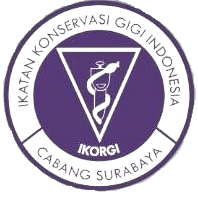Konsentrasi Efektif Daya Antibiofilm Kitosan Cangkang Udang terhadap Streptococcus Viridans (The Effective Concentration of Antibiofilms Capacity from Shrimp Shells Chitosan towards Streptococcus Viridans)
Downloads
Background.Periapical tooth infection is one of infection problems which often happens such as abscess periapical which is caused by bacteria. The bacteria which can form biofilms is named streptococcus viridans. It is resistant towards an antibacterial agent. Chitosan made of shrimp shells is used as a natural antibiofilms agent for streptococcus viridans. Purpose.To determine the effective concentration of antibiofilms capacity from shrimp shells chitosan towards streptococcus viridans. Method.The research method used in this research is laboratory experimental research. The research design is post-test only controlgroup design. Streptococcus viridans is given vortex until it becomes homogeneous with standard turbidity McFarland of 0.5, than, it is planted inside a microtitter plate using TSB Glu for 5x24 hours. At last, Streptococcus viridans is colored using crystal violet and the picture of biofilms is observed using inverted microscope. Chitosan liquid diluted through various concentration 0.195%, 0.39%, 0.78%, 1.56%, 3.125%, 6.25%, 12.5%, 25%, 50% and 100% are going to be added to the microtitter plate and being incubated for 24 hours. The interpretation of the result on the longitude of the wave through optical density is 570nm. Result.There is a significant difference between the concentration of 100%, 50%, 25%, 12.5%, 6.25%, 3.125%, 1.56%, 0.78%, and 0.39% and the control group. Chitosan's effective concentration in resisting the biofilms is 50%. The result is determined by statistical analysis. Conclusion.The effective concentration to resist the formation of Streptococcus viridans biofilms using shrimp shells chitosan is 50%.
Rao N.Advanced Endodontics. 1st ed. USA : Jaypee Brothers Medical Publishers (P) LTD. 2009. p:64-70.
Chandra BS and Khrisna VG.Grossman's Endodontics practice. 12th ed. New Delhi : Wolters Kluwer pvt ltd. 2010. p:81.
Winn W, Allen S, Janda W, Koneman E, Procop G, Schreckenberger P and Woods P.Koneman Color Atlas and Textbook of Diagnostic Microbiology. 6th ed. USA : Lippincott William and Wilkins. 2006.p: 695.
Steven, DL and Kaplan EL.Streptococcal Infections : Clinical Aspects, Microbiology, and Molecular Pathogenesis. ISBN O-19-509921-4. Oxford : Oxford University Press, Inc, 2000. p: 334-336.
Setiawan VM, Estoepangestie S, Koesdarto S. Pembentukan biofilm oleh Streptococcus uberis terkait dengan infeksi kronis intramamary. JBP2012; 14(3):153-157.
Hojo K, Nagaoka, Ohshima, and Maeda. Bacterial interactions in dental biofilm development. Journal of Dental Research2009; 88(11):982-990.
Rhodes, J.S. Advanced Endodontics Clinical Retreatment and Surgery, Taylor and Francis Group London, 2006. p:130.
Saunders, W. Lates Conceptsin Root Canal Treatment. British Dental Journal2005;198(8):515.
Ford, T.R.P.Harty's Endodontics in Clinical Practice, Elsevier Churcil Livingstone, 2004.p:85-86.
Walton, RE and Torabinejad M. Alih bahasa, Narlan Sumawinata. Prinsip dan Praktik Ilmu Endodonsia. Edisi 3. Jakarta : EGC. 2003. p: 230-232.
Wen C, Kao Chia Tze, Tsui Hsien Huang. Comparison of the biocompatibility between 2 endodontic filling material for primary teeth. Chin Dent J 2005; 24(1):28-34.
Nurko, C. Clinical Section Resorption of a Calcium Hydroxide/Iodoform Paste (Vitapex) in Root Canal Therapy for Primary Teeth: A Case Report. Pediatric Dentistry San Antonio2000; 22(6):12-18.
Kurniasih M and Kartika D. Sintesis dan Karakterisasi Fisika-Kimia Kitosan. Jurnal Inovasi2011; 5(1):42-48.
Costa E, Silva S, Tavaria F and Pintado M. Study of the effect of chitosan uponStreptococcus mutans adherence and biofilm formation. J. Anaerob2013; 20:27-31.
Archana V, Prabhuji M, Karthikeyan B and Selvan A. Control of Streptococcus sanguinis oral biofilm by novel chlorhexidine – chitosan mouthwash : an in vitro study.J exp Integr Med2013; 3(2):165-169.
Paz L, resin A, Howard K, Sutherland D and Wejse P.Antimicrobial effect of Chitosan Nanoparticles on streptococcus mutans Biofilms, 2011;77(11):3892-3895.
Costa E, Silva S, Tavaria F and Pintado M.Antimicrobial and Antibiofilm activity of Chitosan on the Oral Pathogen Candida Albicans. Article Pathogens. ISSN 2076-0817. 2014. p: 908-919.
Bakkiyaraj D, Nandhini JR, Malathy Balakumar and Pandian SK. 2013. The anti-biofilm potential of pomegranate (Punica granatum L) extract against human bacterial and fungal pathogens. Biofouling2013; 29(8):930.
Druzina BV, Butarac A, Mrvcic J, Dragicevic TL and Tomas VS. Bacterial Stationary-Phase Evolution. Biotechmol 2011; 49(1):14-19.
Orlando,Orinda and Hiunade. Demonstration of antibiofilm and antifungal efficacy of chitosan against candidal biofilms, using an in vitro central venous catheter model. J. Infect Disc 2009;201(9):1436-1440.

CDJ by Unair is licensed under a Creative Commons Attribution 4.0 International License.
1. The journal allows the author to hold the copyright of the article without restrictions.
2. The journal allows the author(s) to retain publishing rights without restrictions










